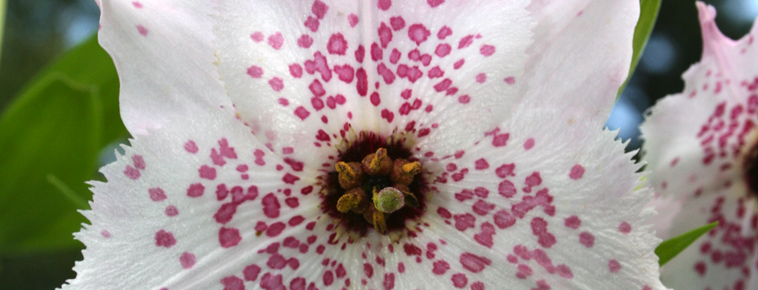
CLUNY GARDENS - CONIFER LIST
This is a list of some of the conifers that can be seen on your walk around the garden. It is in no way complete, but it is hoped it is of benefit to you. The naming of the majority of the trees was due to the efforts of the late Ian Masterton who spent many hours engrossed in books in pursuit of the correct names. We would very much like to thank Tom Christian for all his efforts in revising the list in 2006. The list roughly follows the garden numbering system starting at the plant stall.
CLUNY GARDENS - CONIFER LIST
Format
Latin name ‘Cultivar’– (Common Name). Area of origin. Year of introduction.AT THE START
Tsuga canadensis – (Eastern Hemlock) E. Canada and N.E U.S.A. 1736.Abies grandis – (Grand Fir) Western North America. 1830. Introduced by David Douglas, an important timber tree Sequoia sempervirens ‘Nana Pendula’ – A dwarf horizontal cultivar first found in Cambridge Botanic Garden, which has now decided to grow vertical.
AT NUMBER ONE
Juniperus squamata ‘Meyeri’ – A cultivar introduced from China in 1940.AT THE PLATFORM
Abies forrestii – S.W China. 1910.AT NUMBER THREE
Abies koreana – (Korean Silver Fir) South Korea. 1913. This tree is known for its violet-purple cones, which can be produced from a very young age. Sadly, it is now threatened in the wild. Chamaecyparis lawsoniana (+ several cultivars) – (Lawson’s Cypress) 1854.AT NUMBER FOUR
Sequoiadendron giganteum – (Giant Redwood / Wellingtonia / Big Tree) California. 1853. This tree has a girth of 11 metres and as such is currently the widest conifer in the UK.AT NUMBER FIVE
(On the right) Cedrus deodara – (Deodar) Western Himalaya.1831. (On the left) Abies spectabilis – (East Himalayan Fir) Eastern Himalaya. 1822. (On the right, the very large tree) Abies alba – (European Silver Fir) 1603. This tree is thought to be the oldest in the garden, and may be 200 years old. (On the left, at junction) Picea orientalis – (Oriental Spruce / Caucasus Spruce) 1839. This species has the shortest needles of any Spruce.AT NUMBER SEVEN
(On right, about 2/3 around the loop, a young plant) Pinus wallichiana – the Himalaya. 1823.AT NUMBER NINE
(On the right, a young plant) Taxus baccata – (Yew) A native conifer. (On the left, the low shrubby plant) Podocarpus alpina – S.E Australia and Tasmania. (On the left, two trees very close together) Thuja occidentalis – (White Cedar) Eastern Canada and the Eastern N. U.S.A.Pinus parviflora – (Japanese White Pine) Japan.1861.
IN THE ROCK GARDEN
(working from front to back) Picea albertiana ‘Conica’ Taxus baccata ‘Adpressa Variegata’ Cryptomeria japonica ‘Elegans’AT THE FORK (Turning left)
Thuja plicata – (Western Red Cedar) Western North America. 1853. (On left, before junction with steps) Chamaecyparis lawsoniana ‘Wisselii’ AT THE FORK (Turning right, continuing below lawn) (In large bed on the left) Picea omorika – (Serbian Spruce) Serbia. 1889.(At the top of the steps) Cedrus atlantica ‘Glauca’ – (Blue Atlas Cedar) A cultivar selected for its very blue foliage from the species from N.W Africa. Thujopsis dolobrata – Japan. Introduced around 1860. AT NUMBER FIFTEEN (down steps) Chamaecyparis lawsoniana – (Lawson’s Cypress) Western North America. Picea breweriana – (Brewer’s Weeping Spruce) NW U.S.A. Around 1900.
AT NUMBER SEVENTEEN
(On left, opposite Cedrus deodara, a young plant) Calocedrus decurrens – (Incense Cedar) Western U.S.A 1853. (Half way round bend, on left, only clearly visible in winter) Abies pindrow – (West Himalayan Fir) West Himalaya. 1837.AT NUMBER EIGHTEEN
Pinus nigra var. caramanica – (Crimean Pine) Crimea & W. Asia Minor. 1790.AT NUMBER NINETEEN
(Across stream on right) Abies procera – (Noble Fir) Western U.S.A. 1830. (At the bottom of the steps, on left) Sciadopitys verticillata – (Japanese Umbrella Pine) Japan. 1853. (On the right, on terrace) Xanthocyparis nootkatensis ‘Pendula’ – A well known weeping cultivar of the Nootka Cypress from Alaska.AT NUMBER TWENTY-FOUR
Metasequoia glyptostroboides – (Dawn Redwood) China. 1948. This species was only discovered in 1942, having previously been known only as a fossil. Millions of years ago, one of its close relatives grew on the Isle of Skye!AT VIEWPOINT
(Looking behind you) Pseudotsuga menziesii – (Douglas Fir) Western N.America. 1830.Cryptomeria japonica – (Japanese Cedar) China and Japan. 1842. (Looking in front of you) trees with blue foliage: Abies procera (see No. 19) Also, the very large trees on path at number 29.
AT NUMBER THIRTY-ONE
(To the right) Chamaecyparis lawsoniana ‘Wisselii’(Straight ahead) Chamaecyparis pisifera ‘?’ – A cultivar of the Sawara Cypress from Japan.
On the hill behind the house, walking up the road, then turning right and going around in a large loop (in a clockwise direction), you may find trees of the following species (in order of appearance) Abies veitchii – (Veitch’s Silver Fir) Japan. 1879. Picea breweriana – see at number 15. (Almost in windbreak behind Oak) Abies magnifica – (Red Fir) W. U.S.A 1851.
(Growing under the 2nd oak) Abies balsamea – (Balsam Fir) Eastern North America. 1695.
(After Chestnut, on right) Cupressus arizonica – W. U.S.A. 1880. Cryptomeria japonica (and ‘Elegans) see at viewpoint and in rock garden. Tsuga heterophylla – (Western Hemlock) Western N. America. 1851.
